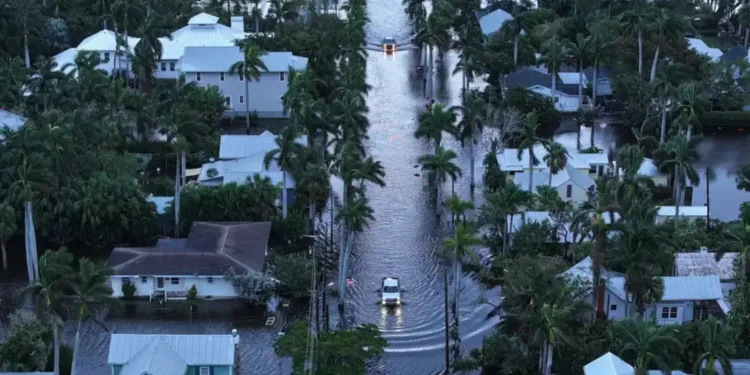Table of Contents
Hurricane Milton left 3 million without power and caused severe flooding across Florida’s Gulf Coast.
October 10, 2024—Hurricane Milton made landfall near Siesta Key, Florida, on Wednesday as a Category 3 storm, bringing powerful winds and significant storm surge. The hurricane has left over 3 million Floridians without power and caused widespread flooding across coastal areas, including Tampa Bay(11Alive). As the storm continues its path inland, officials are warning of ongoing risks and long recovery efforts.
01
of 06Severe Flooding and Power Outages in Tampa Bay
Tampa and nearby regions have been among the hardest hit by Hurricane Milton, with heavy rainfall and rising waters inundating streets and neighborhoods. Flooding has been especially severe in low-lying areas, prompting emergency responders to deploy boats and helicopters to assist with rescue operations. Downtown Tampa saw water levels rise dramatically, with some vehicles fully submerged and roads turned into rivers(11Alive). Many residents are cut off from essential services due to flooded streets, downed power lines, and blocked roadways.
Severe flooding and damage have made conditions near Hillsborough Ave and Dale Mabry in Tampa unsafe for driving. For your safety and the safety of your loved ones, please stay home. pic.twitter.com/3k5oXLsWSx
— HCSO (@HCSOSheriff) October 10, 2024
The storm surge has also caused damage to homes and businesses along the coast. Authorities have warned that additional rainfall in the coming days could exacerbate the flooding, particularly in areas that are already saturated.
Local utility companies are working around the clock to restore power, but officials say it could take days or even weeks in the most affected areas. Florida Power & Light (FPL) reported that crews are prioritizing hospitals and critical infrastructure but that repairs are slowed by continuing unsafe conditions.
02
of 06Extensive Evacuations and Emergency Shelters
Prior to Milton’s landfall, tens of thousands of residents along the Gulf Coast were evacuated to safer areas. Counties in the storm’s path, including Sarasota, Pinellas, and Hillsborough, issued mandatory evacuation orders. As a result, shelters across the region have been operating at capacity. Hotels and campgrounds in inland areas also quickly filled up with evacuees.
State officials have also opened several emergency shelters across northern Florida and southern Georgia, where evacuees have sought refuge from the storm. Georgia’s Governor has encouraged residents to prepare for heavy rains and potential flash flooding in coastal areas as the storm progresses(11Alive).
The Tampa International Airport was forced to close as the storm approached, canceling all incoming and outgoing flights. Residents have been advised to stay indoors and off the roads until local officials declare it safe to return.
03
of 06Ongoing Search and Rescue Operations
Florida’s National Guard, along with local police and emergency response teams, are actively engaged in search and rescue missions. Helicopters have been flying over the flooded regions to identify stranded residents, while boats are being used to reach people cut off by rising waters. Governor Ron DeSantis addressed the public, stating, “Our top priority is saving lives. As soon as conditions allow, we’ll begin damage assessments and continue helping those in need.”
Rescue efforts are being focused in some of the worst-affected areas, including Sarasota and Bradenton, where wind damage and storm surges have been particularly severe. Local hospitals are operating on backup power, and state officials have requested additional medical supplies and personnel to assist in the response.
04
of 06Milton’s Impact Moving North
After striking Florida, Hurricane Milton weakened slightly but still posed a serious threat as it moved northward through Georgia and the Carolinas. Coastal areas of Georgia are under tropical storm warnings, with meteorologists predicting heavy rainfall and potential flash floods over the next 24 to 48 hours(11Alive). Savannah, in particular, is preparing for possible coastal flooding as storm surges and high tides converge.
Forecasters predict that up to 12 inches of rain could fall in parts of northern Florida and Georgia, leading to concerns about flash floods in rural areas. In addition, strong winds could down trees and power lines, increasing the risk of further power outages across the region.
05
of 06Federal and State Response
In response to the storm, President Joe Biden issued a federal emergency declaration authorizing FEMA to coordinate disaster relief efforts in Florida. Search and rescue operations are being supported by federal resources, and FEMA teams are working to assess the full extent of the damage. Aid packages, including food, water, and emergency supplies, have been dispatched to assist evacuees and residents in hard-hit areas(11Alive).
Rescue efforts continue and severe flooding throughout the county. Hurricane #Milton pic.twitter.com/8mbrW5C17G
— Pinellas County Sheriff's Office (@SheriffPinellas) October 10, 2024
The federal government is working closely with Florida officials to provide financial aid for rebuilding efforts, which are expected to take months. The storm’s impact on local economies could be significant, particularly in tourist-heavy areas like the Tampa Bay region, where businesses have been severely affected by both flooding and power outages.
06
of 06Long-Term Recovery Efforts
The aftermath of Hurricane Milton will require a sustained recovery effort. With widespread infrastructure damage, it will take weeks to restore power in some areas and months to repair damaged buildings and roads. Officials are urging residents to remain patient and follow all safety guidelines, as many hazards, such as downed power lines and contaminated floodwaters, remain a threat.
Residents are being advised to monitor local authorities for updates on when it will be safe to return to their homes. The long-term economic impact of the storm, particularly on Florida’s tourism and agriculture industries, is still being assessed.
































